4 ways sea level rise and climate change are reshaping the coast
Bill Nuttle ·The experience of the last several generations has been that, while we cannot master the processes that shape the coast, we have been able to anticipate and mitigate their impact. The position of the coastline reflects the interplay of dynamic processes. Until recently, these processes have maintained a rough equilibrium. Most places in the US, the coastline has changed little in the 150 years since it was first mapped by the Coast Survey. Where large changes have occurred, often these are the result of efforts to reshape the coast for our purposes.
But, global warming changes all of that. Climate change and accelerated sea level rise tip the balance away from equilibrium. Digital mapping tools and LIDAR surveys help us visualize how much the coast will change when sea level is 3, 5, 10 feet higher than it is now. No one can say for certain how long it will take for these new coastlines will appear, or how long they will last. The era of coastal equilibrium that we have been accustomed to is over. We are entering an uncertain era of coastal change.
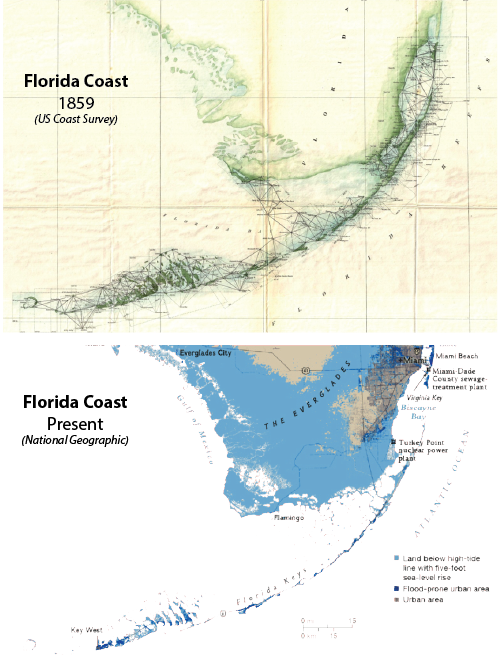
Therefore, coastal communities must become resilient if they are to survive. People won’t abandon living along the coast immediately, because there are still plenty of good reasons to stay. People must adapt, and this requires understanding the new mechanics of the coastal environment. Coastal scientists and engineers have begun to make progress on the first step, which is to recognize the mechanisms at work.
Here are four different ways that sea level rise and climate change are reshaping the coast:
1 - Increased tidal flooding
Sea level rise shifts the range of tides upward, and this increases the frequency of flooding of low areas on the highest tides, a phenomenon known as nuisance flooding. The threshold water level at which nuisance flooding occurs varies from location to location, but as a rule of thumb it occurs when tide levels exceed 2 feet above mean higher high water (MHHW). The consequences are usually minor – standing water in a low spot on the road or waves overtopping a seawall. However, nuisance flooding can disrupt traffic and damage infrastructure, resulting in lost business and increased maintenance costs.
Nuisance flooding is occurring more frequently along the coasts of the US. The increase has been greatest in Baltimore and Annapolis, Maryland, where the number of days in a year with nuisance flooding increased by nearly a factor of ten between 1960 and 2014 [Sea Level Rise and Nuisance Flood Frequency Changes around the United States, pdf]. In Port Isabel, Texas, the frequency of nuisance flooding is now more than five times greater, and in San Francisco, California, it is more than three and a half times greater.
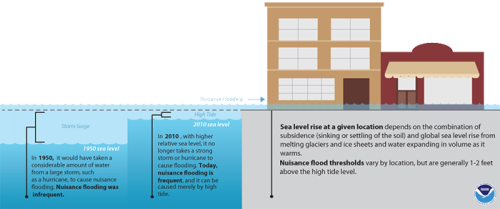
2 - More damaging storm surge
Flooding from storms is increasing along the East Coast. Flooding from storm surge is far more damaging than tidal flooding, because storm surge adds on top of the tides and it is accompanied by high winds and waves. Sea level rise adds to the height of storm surge, and this increases the extent of flooding. Climate change contributes by increasing the frequency and intensity of coastal storms. Some estimate that the extreme flooding that occurred in New Jersey and New York from Hurricane Sandy in 2012 will become the norm by the middle of this century.
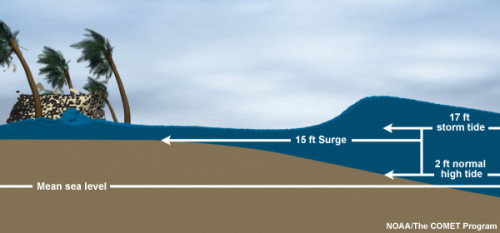
3 - Flooding from below
Sea level rise causes flooding from below by driving sea water into coastal aquifers and raising the groundwater table. This presents a number of problems for people living near sea level. In South Florida nearly a third of the population, 2.4 million people, are vulnerable because they live at an elevation less than 4 feet above sea level. The intrusion of saltwater into coastal aquifers contaminates supplies of fresh groundwater with salt, making it undrinkable [Florida Water Management and Adaptation in the Face of Climate Change, pdf]. A rise in the watertable saturates the soil, which affects the reliability of essential below-ground infrastructure [Improving the Resilience of a Municipal Water Utility Against the Likely Impacts of Climate Change, pdf], such as pipes used for water distribution, sewage collection, and stormwater drainage and cables for power and communications. An increase in the watertable also affects the condition of roadways by making the pavement unstable and more easily damaged.
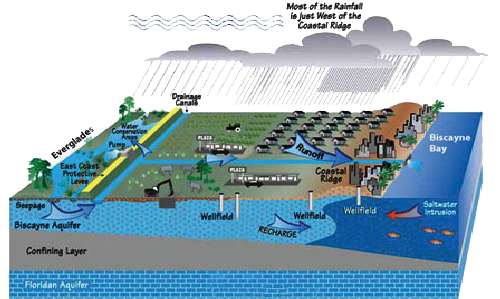
4 – Altered runoff hydrology
Sea level rise and climate change aggravate flooding from rainfall in low-lying coastal areas from rainfall. Sea level rise reduces the capacity of the soil to absorb rainfall by raising the watertable. This results in increased runoff, which increases and the amount of surface flooding that occur during a rainfall event. Storm surge aggravates rainfall even if the storm surge does not cause flooding itself, a phenomenon known as compound flooding. High water levels in coastal waters decrease the capacity of gravity-driven storm water drains to remove water by decreasing the available hydraulic gradient. Decreased drainage capacity translates into increased surface flooding during rainfall [Florida Water Management and Adaptation in the Face of Climate Change, pdf].
Climate change also plays a role. Both the intensity of rainfall events and the frequency of coastal rainfall coinciding with storm surge have increased. This trend is documented in a recent study of rainfall in US coastal cities. For New York City, as an example, certain combinations of rainfall and storm surge occur are twice as likely to occur now than in the middle of the 20th century.
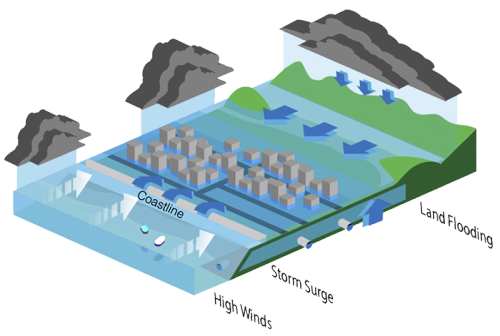
Selected references:
- Berry, L., Bloetscher, F., Hernández Hammer, N., Koch-Rose, M., Mitsova-Boneva, D., Restrepo, J., Root, T., Teegavarapu, R., 2011: Florida Water Management and Adaptation in the Face of Climate Change, Florida Climate Change Task Force. [pdf]
- Horton, R., Little, C., Gornitz, V., Bader, D., Oppenheimer, M., 2015. New York City Panel on Climate Change 2015 Report Chapter 2: Sea Level Rise and Coastal Storms. Annals of the New York Academy of Sciences, V1336(1):1749-6632.
- Sweet, W., Park, J., Marra, J., Zervas, C., 2014. Sea Level Rise and Nuisance Flood. NOAA Technical Report NOS CO-OPS 073. June 2014. [pdf]
- Wahl, T., Jain, S., Bender, J., Meyers, S.D., Luther, M.E., 2015. Increasing risk of compound flooding from storm surge and rainfall for major US cities. Nature Clim. Change 5(12):1093-1097.

